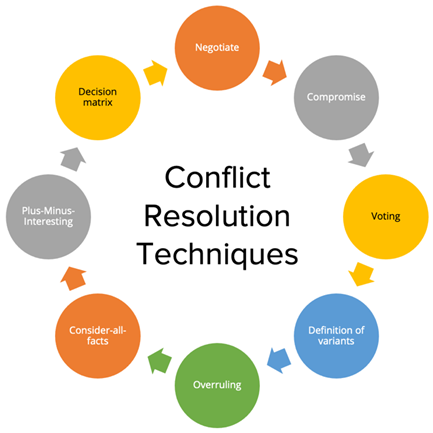The four key components of Strategy Analysis are principles, practices, techniques, and skills. They play an essential role in identifying and validating the organization’s strategic needs, defining suitable solution approach(es) and solution(s), and planning, monitoring, and engaging stakeholders to achieve the organization’s strategic objectives. Techniques describe a step-by-step approach to conducting Strategic Analysis activities.
Need a technique to identify and address underlying issues that may be causing conflicts within an organization? Here is a Strategy Analysis technique to achieve that. This blog will look at a technique called Conflict Resolution with examples.
Conflict resolution as a strategy analysis technique has a long and varied history. Historically, conflict resolution has been used as a tool for resolving disputes between two or more parties. This practice dates back to the early days of human civilization when people sought to resolve interpersonal conflicts through negotiation and mediation. Over the centuries, the practice of conflict resolution has evolved to include more formalized processes such as arbitration, litigation, and arbitration mediation.
In the 20th century, the fields of conflict resolution and strategy analysis began to converge as more organizations began to recognize the importance of conflict resolution in achieving organizational objectives. Conflict resolution was increasingly seen as an important tool for identifying and resolving underlying causes of conflict. This led to the development of various models and frameworks for analyzing and resolving conflicts, such as game theory and the Harvard Negotiation Project. check out more info about cbap training course online
Today, conflict resolution is a core component of many strategy analysis techniques. It is used to identify and address underlying issues that may be causing conflicts within an organization, as well as to develop strategies to prevent and manage conflicts more effectively. It is also used to assess the success of the implementation of a strategic plan, as well as to evaluate the effectiveness of different approaches to conflict resolution.
Purpose
Effective conflict resolution is key to a strategic initiative’s success. Strategy Analysts should pay attention to potential conflicts so that they can be identified, analyzed, and resolved early.
Description
Conflict resolution strategies have a significant effect on the willingness of stakeholders involved to continue working along. Unfair conflict resolutions lead to decreased engagement and collaboration in the strategic initiative. All relevant stakeholders must be involved during conflict resolutions. Business analyst interview questions PDF file you can download here

Figure 22: Conflict Resolution Techniques
Negotiate
Conflicting parties negotiate a solution to the conflict. They exchange information, arguments, and opinions and try to convince one another of each other’s viewpoints to achieve an agreeable solution.
Compromise
Conflicting parties compromise to a solution where each party is willing to sacrifice certain aspects.
Voting
Conflict parties vote on solution alternatives, and the alternative with the most votes is accepted as the resolution for the conflict.
Definition of variants
The system is developed in a way that permits different behaviors by use of variants (or parameters). For example, the system behaves differently for processes executed in country A vs. country B.
Overruling
Conflict is resolved by means of formal authority. It should be used only if other resolution techniques have failed or are not feasible due to resource limitations (e.g., time).
Consider-all-facts
Investigate all influencing factors of a conflict. Determine relevance by prioritizing influence factors. Based on the results of this technique, apply Plus-Minus- Interesting technique.
Plus-Minus-Interesting
Investigate all positive and negative repercussions of a solution’s alternatives. Positive repercussions are placed in the category “Plus,” negative repercussions in the category “Minus,” and rest as “Interesting.” Choose a solution with maximum pluses.
Decision matrix
Create a decision table that contains solution alternatives in columns and all relevant decision criteria in rows. Identify decision criteria using the technique “consider-all- facts.” Assess each combination of criterion and solution alternative, for example, by means of a point scale ranging from irrelevant (0 points) to relevant (10 points). Calculate sums of columns in order to find a solution. Accept solution alternatives with the highest score.
Usage considerations
Resolving conflicts at work can help in building a stronger work environment and create a calm atmosphere where employees interact in a respectful and encouraging way.
Advantages of Conflict Resolution as a strategy analysis technique
- Improved Communication: Conflict resolution strategies facilitate better communication between different parties involved in a conflict. This improved communication leads to a better understanding of the other person’s point of view and helps to identify areas of compromise.
- Increased Understanding: Conflict resolution strategies also help to increase understanding between different parties involved in a conflict. By understanding different points of view and coming to common ground, the parties involved can come to a resolution more quickly and efficiently.
- Reduced Stress: Conflict resolution strategies help to reduce stress levels by helping to create an environment of trust and understanding. This can lead to better decision-making and a better overall resolution.
- Improved Relationships: Conflict resolution strategies help to improve relationships between different parties involved in a conflict. Understanding different points of view help to create a more positive relationship between parties.
- Increased Efficiency: Conflict resolution strategies help to increase efficiency by helping to save time and resources. Resolving conflicts quickly and efficiently helps to save money and time and can help to keep productivity levels high.
Weaknesses of Conflict Resolution as a strategy analysis technique
- Time-consuming: Conflict resolution is a process that takes time. It requires individuals to take the time to listen to each other, understand each other’s perspectives, and discuss solutions. This can be difficult for busy teams and organizations.
- Not always successful: Conflict resolution does not always lead to successful outcomes. In some cases, disagreements may be so deep-seated that it is impossible to come to an agreement.
- Potential for further conflict: Conflict resolution can sometimes lead to further conflict or tension. Without proper facilitation, individuals may use the process as an opportunity to rehash the same arguments or to create a hostile environment.
- Requires skilled facilitators: Conflict resolution requires skilled facilitators to ensure that the process is successful. Facilitators must be able to remain impartial, encourage productive conversations, and recognize when tensions are high and need to be addressed.
- Expensive: Conflict resolution can be expensive, as it often requires the services of a professional mediator or facilitator. This cost can be a barrier to organizations that may not have the resources to invest in the process.
Relationship of Conflict Resolution with other strategy analysis techniques
Conflict resolution is a strategy analysis technique that can be used in conjunction with other strategy analysis techniques to help organizations effectively analyze and respond to conflicts. For example, conflict resolution can be used in conjunction with competitor analysis to help identify areas of potential conflict and develop strategies to manage these conflicts.
Additionally, conflict resolution can be used in conjunction with swot analysis to develop strategies to address areas of weakness or strength that may contribute to conflict. Finally, conflict resolution can be used in conjunction with scenario planning to anticipate potential conflicts and develop strategies to address them.
Future of Conflict Resolution as a strategy analysis technique
The future of Conflict Resolution as an analysis technique is very promising. With the increasing complexity of international relations and the need for effective solutions to disputes, Conflict Resolution will continue to be an important tool for resolving conflicts. Conflict Resolution strategies also have the potential to be used in addressing a variety of other issues, such as environmental protection, human rights, and economic development.
As the world continues to globalize, Conflict Resolution will become even more important in addressing both local and global issues. Conflict Resolution strategies can also be adapted in order to address specific cultural contexts and be used to bridge cultural divides. In addition, Conflict Resolution can be used to facilitate the peaceful resolution of conflicts across a range of contexts, including business, political, and cultural. As a result, Conflict Resolution is likely to remain an important tool for addressing conflicts and resolving disputes in the future.







